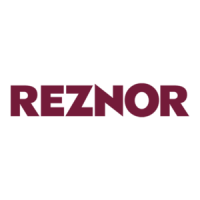I-RX-RG-RPV (09-19) PN1027501R0
21
• For natural gas: Manifold gas pressure is regulated by the combination valve to 3.5 IN WC. Inlet pressure to the
valve must be a minimum of 5 IN WC or as noted on the rating plate and a maximum of 14 IN WC.
• Minimum natural gas supply pressure: Requirements vary based on size of burner and the gas control option.
Most units require a minimum of 5 IN WC natural gas as stated above, but sizes 350 and 400 with electronic
modulation require a minimum of 6 IN WC natural gas supply pressure. Sizes 300 and 350 with mechanical
modulation require 7 IN WC.
• For propane gas: Manifold gas pressure is regulated by the combination valve to 10 IN WC. Inlet pressure to the
valve must be a minimum of 11 IN WC and a maximum of 14 IN WC.
Checking Manifold Pressure
Check the manifold pressure as follows:
NOTE: A manometer (fluid-filled gauge) is recommended rather than a spring-type gauge due to
the difficulty of maintaining calibration of a spring-type gauge.
1. With the manual valve (on the combination valve) positioned to prevent flow to the main burners, connect a
manometer to the 1/8-inch pipe outlet pressure tap in the valve.
2. Open the valve and operate the heater. Measure the gas pressure to the manifold.
3. Normally, adjustments to the factory-preset regulator should not be necessary. If adjustment is necessary, set
pressure to correct settings by turning the regulator screw IN (clockwise) to increase pressure. Turn the regulator
screw OUT (counterclockwise) to decrease pressure. Consult the valve manufacturer’s literature provided with
the furnace for more detailed information.
Electrical Supply and Connections
⚠ WARNING ⚠
If you turn OFF the power supply, turn OFF the gas.
⚠ CAUTION ⚠
If any of the original wire as supplied with the appliance must be replaced, the replacement wiring
material must have a temperature rating of at least 221°F (105°C), except for the limit control, the
sensor lead, and the optional bypass damper combustion air safety circuit (option AG39 or AG40)
wires, which must be rated at 302°F (150°C).
• All electrical wiring and connections, including electrical grounding, MUST be made in accordance with the National
Electric Code ANSI/NFPA No. 70 (latest edition) or in Canada, the Canadian Electrical Code. Part 1-C.S.A.
Standard C22.1. In addition, the installer should be aware of any local ordinances or gas company requirements
that might apply.
• Check the rating plate on the heater for the supply voltage and current requirements. A separate line voltage
supply with fused disconnect switch should be run directly from the main electrical panel to the furnace, making
connection to leads in the junction box. All external wiring must be within approved conduit and must have a
minimum temperature rise of 140°F (60°C). Conduit from the disconnect switch must be run so as not to interfere
with the service panels of the furnace.
• If the heater has field-installed options that require electrical connections, consult the instruction sheet and wiring
diagram supplied in the option package.
• Specific wiring diagrams that include standard and factory-installed options are included with the heater. Typical
wiring diagrams are shown in Figure 17 and Figure 18.

